ISSN ONLINE(2278-8875) PRINT (2320-3765)
ISSN ONLINE(2278-8875) PRINT (2320-3765)
B. S. Deore1, N. A. Dawande2
|
| Related article at Pubmed, Scholar Google |
Visit for more related articles at International Journal of Advanced Research in Electrical, Electronics and Instrumentation Engineering
A WPIMS system based on the embedded Internet technology for embedded devices is designed and implemented.WPIMS system is located centrally at the tower infrastructure service provider premises to monitor the various PMSs. The WPIMS NOC is designed for modularity and scalability and comprises of a Communication Server, a Data Server and various User Terminals. The embedded device communicates through General Packet Radio Service (GPRS), which makes it accessible from anywhere in the world through a web server built into the embedded device. The bandwidth requirements of the leased line would be based on the total number of WPIMS agents being monitored / controlled. Asynchronous events / alarms that occur at the PMS are received and processed by the Communication Server.
Keywords |
| Remote Monitoring, PMS, WPIMS, NOC |
INTRODUCTION |
| Now requirement of remote monitoring is increasing for Sensing and Managing of temperature, voltage, current and such parameters. To obtain effective way of monitoring by using microcontroller based technology and internet web pages. The embedded device communicates through General Packet Radio Service (GPRS), which makes it accessible from anywhere in the world through a web server built into the embedded device. Each cell-site tower is equipped with a Power Management System. Each communication server is connected to the GPRS / CDMA network service provider via a leased line. Asynchronous events / alarms that occur at the PMS are received and processed by the communication server. |
| The structure of the paper is as follows. In Section II we describe the System model development in this paper, section III we shown system initialization, Section IV describes the experimental result and section V contains brief conclusions. |
SYSTEM MODEL DEVELOPMENT |
| The embedded system hardware and software depends on the product type, analysis required and the communication port available with the product or not. If it is available then check its type and other product dependent parameters. The user has to specify what is normal and what is abnormal. The timely report even if the product is functioning normal, service call alerts etc. At the centre a server with suitable software to handle internet and a huge database is used and a provision for sending EMAILS on a given address as per the product is sent for immediate action so that no operator is required at the server centre. |
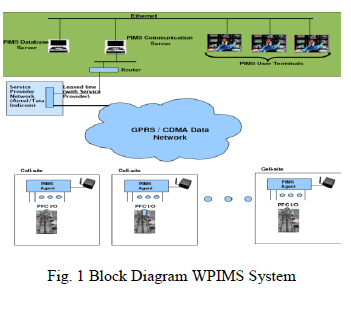 |
| Fig. 1show the Block Diagram WPIMS System, GSM and GPRS are developed for cellular mobile communication. A GPRS connection with unlimited duration of connectivity is changed only for the data package transfers and adopted in several mobile remote control/access systems. GPRS becomes a cost – effective solution only if the data transfers can be optimized. |
| At the Centre a server with suitable software to handle internet and a huge database is used and a provision for sending EMAILS on a given address as per the product is sent for immediate action so that no operator is required at the server Centre. |
| The framework is based on GPRS data connectivity between the WPIMS communication server and the WPIMS agents with the entire communication being TCP/IP based. An application based protocol framework is present for message exchange between the WPIMS communication server and the WPIMS agents. Messages are defined for event reporting, health & status information, and control operations. |
| A. WPIMS Agent |
| The WPIMS agents are devices that co-habit with the PMS system at each cell tower location. They are connected to the PMS system for status / health monitoring. The following diagram depicts the structure of the WPIMS agent. |
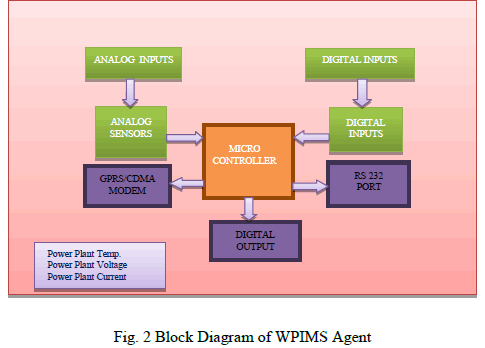 |
| As shown in fig. 2 WPIMS agent which can monitor a given product by using the best and reliable mode of communication from the site to the central monitoring point in case occurrence of any abnormalities in the product or after a period specified by the user of the system. |
| To some degree or another, most sensor outputs are non-linear with respect to the applied stimulus, and as a result their outputs must often be linearized in order to yield correct measurements. Analog is one viable route, and such techniques may be used to perform an “analog domain” linearization function. However, the recent introduction of high performance ADCs now allows linearization to be done much more efficiently and accurately in software. This “digital domain” approach to linearization eliminates the need for tedious manual calibration using multiple and sometimes interactive analog trim adjustments. |
| Every site is added with a client unit which collects data from the product and identifies the abnormalities and communicates with the Centre via GPRS link on GSM/GPRS MODEM the Centre is having internet connection with static IP and number of such clients can communicate with the many number of Centre. The way of embedding the Web server in the device makes it possible for numerous embedded devices to be connected to the Internet. The results of system performance testing show that the system can meet most of the embedded Internet applications demands and the purposes of online access., control and management the embedded devices using a standard Web browser over the Internet can be realized. |
SYSTEM INITIALIZATION |
| Once the system is started, it is required to initialize the system. Such as LCD, ADC, Controller, etc. It needs to initialize the LCD first then enter the password to verify the user. Once the password is verified system will initialize the ADC and display the message for the same. It selects the first channel of the ADC and read the information of the corresponding channel which is connected to the sensor. |
| A. Flow Chart 1 Initialization of system |
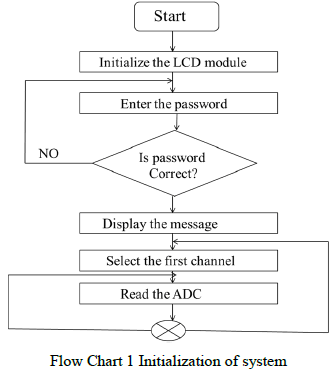 |
| It selects the first channel of the ADC and read the information of the corresponding channel which is connected to the sensor. Then calibrate the output of the sensor and display the calibrated value. The calibrated information was transmitted through the communication channels. Then it increment the channel and read the information of the second channel. Again it calibrates the information and transmits it. Same procedure is repeated for all channels and it continuously monitor the sensors output. |
| B. Flow Chart of Data Reading |
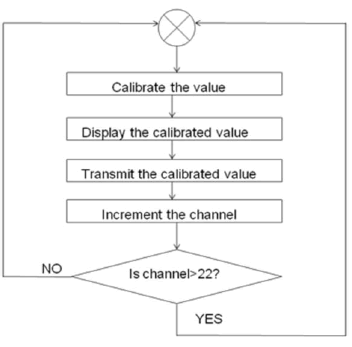 |
| Flow Chart 2 Data Reading from channels Once the system is initialized WPIMS reads data from all inputs. All the analog and digital channels are scanned and the data is sent to the controller. The controller sends this data to monitoring system; it reads the data from input and sends it to monitoring system continuously. |
RESULT |
| The monitored date can be stored on the computer as well as it can be compared with the standard set of result. The procedure to obtain the date from the WPIMS to the computer with the help of HyperTerminal:- Start the HyperTerminal .exe program by selecting Start -> Programs -> Accessories ->Communications -> HyperTerminal. |
| To communicate the user computer with the other side of the remote connection is made possible through the scroll feature of HyperTerminal. Or use an existing Ethernet network to connect to and monitor data loggers remotely on an on-going basis. Or monitor the data on remote machine with the socket server. We obtain the result as shown, |
 |
| Graph: 1 indicate the set levels of the various parameters to be monitor. |
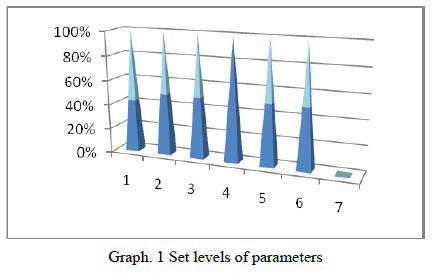 |
| Graph: 2 indicate the comparison with the standard set of result of the various parameters to be monitor. The standard set of result is indicated by blue cones and the monitored parameters are indicated by red cones. |
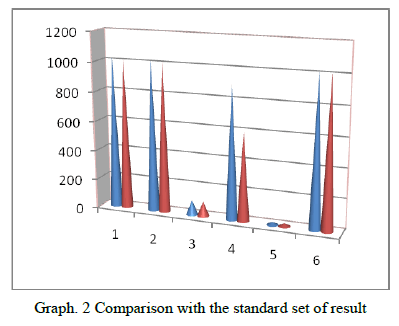 |
CONCLUSION |
| The system adopts Browser / Server mode and realizes the interconnection of the embedded devices. Therefore, remote users can access, control and manage the embedded devices using a standard Web browser over the internet. It has advantages of small size, longer work time and stable performance. It is easier, flexible, and more user-friendly. The greatest benefit to Embedded Internet of Embedded Web Server (EWS) is without a doubt the availability of a standard connection to the outside world. There are some technologies, which provide solutions to the wireless data transmission network, such as: GSM, CDMA, 3G, and Wi-Fi. These solutions make network work with high efficiency and good quality, but still with high cost, so wider application would cause a great waste of resources, and they cannot promoted in small regional and low speed data communication. |
References |
|